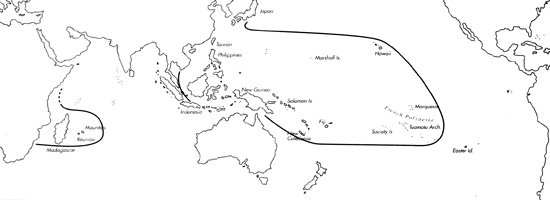Range: Mozambique to Tanzania, to Hawaii and French Polynesia.
Description: Moderately small to moderately large, moderately solid to solid. Last whorl ventricosely conical to ovate or slightly pyriform; outline strongly convex adapically, straight to concave below, more concave on left side. Shoulder rounded to almost indistinct. Spire of low to moderate height, outline straight to convex or slightly sigmoid. Larval shell of about 3.25 whorls, maximum diameter about 0.8 mm. First 5-6 postnuclear whorls tuberculate. Teleoconch sutural ramps flat to slightly convex, with 1 increasing to 4-7 spiral grooves; additional spiral striae on latest ramps. Last whorl with prominent spiral ribs basally and weak to obsolete spiral ribs or ribbons above.
| Shell Morphometry | ||
|---|---|---|
| L | 27-69 mm | |
| RW | 0.15-0.37 g/mm | |
| (L 35-54 mm) | ||
| RD | 0.57-0.70 | |
| PMD | 0.72-0.82 | |
| RSH | 0.11-0.17 | |
Ground colour white to pale pink. Last whorl usually with 2 broad yellowish brown spiral bands leaving 3 zones of reticulated fine brown lines, at centre, at base, and below shoulder. Brown areas interspersed with blackish brown axial lines and streaks. Shells with sparse tents and prominent blackish brown axial streaks intergrade with shells with fine reticulation and light brown spiral bands. Larval whorls and first 1-4 postnuclear sutural ramps immaculate pale pink. Following ramps matching last whorl in colour pattern. Aperture white, bluish white or light pink.
Periostracum pale yellow, thin, translucent, smooth.
Foot white, mottled with brown; dorsum with black markings laterally. Tentacles white, tipped with orange-red. Siphon white, tipped with orange-red to red, with a broad black ring centrally (Kohn, 1959a; Pearson, pers. comm., 1990).
Radular teeth with 2 opposed barbs adapically; long serration ending in a cusp about 1/4 of the length from the base (Kohn, unpubl. observ.).
Habitat and Habits: Intertidal to about 40 m, less frequent below 15 m; from intertidal benches to the outer side of coral reefs, inhabiting sand, rubble, algal turf, dead as well as living coral and caves (Kohn, 1959b; Cernohorsky, 1964; Kay, 1979; Kohn & Leviten, 1980; Estival, 1981; Tirard, pers. comm., 1989; Richards, pers. comm., 1989; Grosch, pers. comm., 1989). Egg diameter of about 250 ┬Ám predicting a minimum pelagic period of about 19 days (E. Indian Ocean; Perron & Kohn, 1985).
Discussion: C. retifer may be similar to C. legatus and C. textile form verriculum; for comparison, see the Discussions of the latter species. Dead shells of C. retifer have been found in excavated material in Maldives; they appear to represent an extinct population.

C. retifer range map
This section contains verbatim reproductions of the accounts of 316 species of Conus from the Indo-Pacific region, from Manual of the Living Conidae, by R÷ckel, Korn and Kohn (1995). They are reproduced with the kind permission of the present publisher, Conchbooks.
All plates and figures referred to in the text are also in R÷ckel, Korn & Kohn, 1995. Manual of the Living Conidae Vol. 1: Indo-Pacific Region.
The range maps have been modified so that each species account has it own map, rather than one map that showed the ranges of several species in the original work. This was necessary because each species account is on a separate page on the website and not confined to the order of accounts in the book.